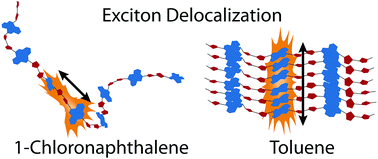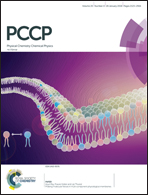Solvent-mediated aggregate formation of PNDIT2: decreasing the available conformational subspace by introducing locally highly ordered domains†
Abstract
The high-mobility n-type donor/acceptor polymer PNDIT2 is well-known to form aggregates in solution depending on the solvent used. To gain additional insight into this process, we probed the local environment of triplet excitons in two different solvents and with two different polymer chain lengths using time-resolved electron paramagnetic resonance (TREPR) spectroscopy. Results clearly show aggregation to introduce a high degree of local order in the polymer and to dramatically enhance the delocalisation of the exciton. Furthermore, triplet exciton delocalisation is only affected by the solvent used and hence by aggregate formation, not by chain length. Finally, aggregation changes the mode of delocalisation from intrachain to interchain when forming aggregates, the latter mode dominating as well in thin films. Taken together, TREPR proves to be a valuable tool for investigating aggregation and order in polymers on a molecular length-scale, ideally complementing preceding optical data.

- This article is part of the themed collection: 2018 PCCP HOT Articles


 Please wait while we load your content...
Please wait while we load your content...